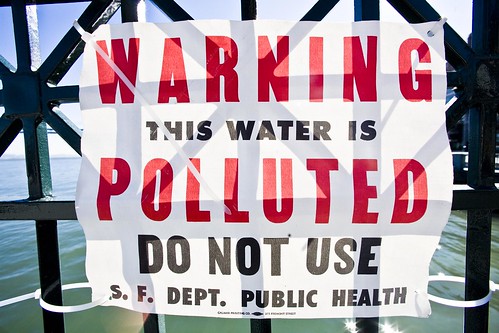
U.S. Waters Still Toxic Dump Sites
10/28/2009

A new report from Environment America uncovers a dirty truth in publicly available government databases about the country’s waterways – widespread toxic pollution dumped by industrial facilities. More than 230 million pounds of toxics were discharged into 1,900 waterways across all 50 states in 2007, including chemicals known to cause cancer and birth defects.
The report, Wasting our Waterways: Toxic Industrial Pollution and the Unfulfilled Promise of the Clean Water Act, draws on publicly available data collected by the U.S. Environmental Protection Agency (EPA) and other agencies, underscoring the importance of public right-to-know laws, which enable citizens to use information to hold government and polluters accountable. Key among the government databases used was the 2007 Toxics Release Inventory (TRI), a public database maintained by EPA that tracks the releases and transfers by a wide range of facilities nationwide of more than 600 toxic substances.
Environment America used the data to not only determine the overall pollution levels from industrial facilities, but also to identify specific facilities with the highest amount of toxic water waste. For instance, the report identifies AK Steel Corporation's Rockport, IN, plant as the facility with single highest waterway discharges of toxics in the whole country. In 2007, the facility dumped more than 24 million pounds of toxic nitrate compounds into the Ohio River. In addition to their toxicity, nitrate compounds are largely responsible for the colossal "dead zones" that perennially afflict water bodies such as the Gulf of Mexico, where the Ohio River's waters eventually end up.
The federal government also appears among the report's list of the top twenty polluters. The U.S. Army's Radford Ammunition Plant in Virginia dumped 13.6 million pounds of nitrate compounds into the New River, making it the second biggest water polluter in 2007 and another contributor to dead zones. Scientists consider pollution from agricultural storm water runoff to be a much larger contributor to dead zones, but TRI does not track agricultural runoff, and measuring such pollution has been problematic.
The study also draws on scientific data developed by the state of California to characterize the types of harm that specific chemicals might cause. California's Proposition 65 database includes approximately 800 chemicals known to cause cancer, birth defects, or other reproductive harm.
The report explains that "among the potential health effects of [developmental and reproductive toxicants] are fetal death, structural defects such as cleft lip/palette and heart abnormalities, as well as neurological, hormonal, and immune system problems."
Weyerhaeuser's Pine Hill, AL, paper mill released the most developmental toxicants into a waterway in 2007. In addition to 35,000 pounds of the pesticide nabam and 35,000 pounds of the biocide sodium dimethyldithiocarbamate, the mill discharged lead, mercury, and zinc into the Alabama River.
Several shortcomings with the TRI database are exposed by the report. Misspelled or inconsistent names of waterways made regional tracking of pollution difficult. To ensure the right bodies of water were identified, the authors were forced to review and repair manually thousands of records. The TRI program also has several important gaps in the information collected. The program currently does not cover several industries especially relevant to waterway pollution, such as wastewater treatment plants and agricultural facilities. The list of chemicals reported to TRI omits numerous important water pollutants, and small facilities are excluded from the program entirely.
For the most part, toxic releases reported to TRI fall within a facility's permitted levels. In response to the report, several large polluters emphasized their compliance with their water pollution permits. However, the report's authors present the data in an effort to defend their calls for stricter permits. Such disclosures of a company's pollution often also result in public pressure on companies to voluntarily reduce their emissions.
Enforcement of and compliance with the nation's primary water protection statute, the Clean Water Act (CWA), have been weak in recent years. The New York Times is currently running a series describing the worsening pollution problems with American waterways and the feeble enforcement of clean water laws. According to the Times, "In the past five years, companies and workplaces have violated pollution laws more than 500,000 times. But the vast majority of polluters have escaped punishment."
The Environment America report also makes clear that even if widespread compliance with CWA permits were achieved, the nation's waterways would still be severely harmed unless permitted pollution levels are reduced.
The report includes recommendations for policymakers to improve the health of the nation's waters. The policy emphasis should be placed on reducing the use of toxic chemicals in industry by promoting safer substitutes. First, the country's chemical policy must be reworked to regulate chemicals based on their intrinsic hazards, with the goal of eliminating public exposure to hazardous substances. Additionally, chemical manufacturers should be required to test the safety of their products and disclose all results prior to putting the chemicals on the market.
The authors also call on federal policymakers to strengthen implementation of the Clean Water Act. Their first recommendation is to ensure pollution permits are renewed on schedule and permitted levels of pollution are ratcheted down, with the goal of eliminating pollution entirely –as the CWA calls for. Moreover, the penalties for violating the CWA should be strengthened by establishing mandatory minimum penalties. Congress is called upon to ensure EPA has adequate resources and staff to meet its CWA requirements.
Image in teaser from flickr user Thomas Hawk, used under a Creative Commons license


